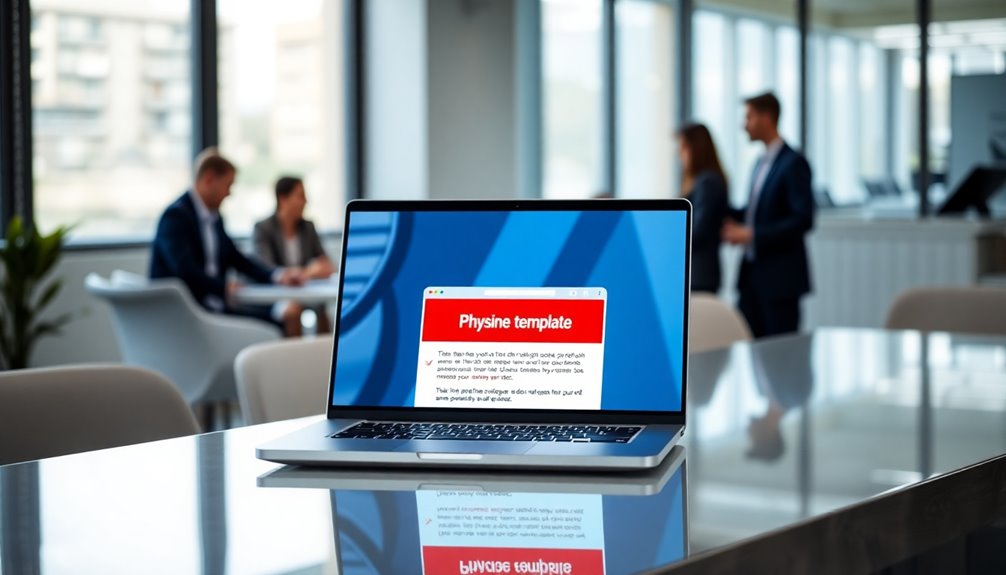An effective email template for phishing awareness is vital for keeping your team safe from cyber threats. It should motivate your colleagues to remain vigilant and recognize suspicious emails. Start with a clear call to action, urging immediate reporting of any dubious messages. Include real examples and attention-grabbing statistics to drive the message home. Use concise language and common indicators of phishing, like odd sender addresses or urgent requests. Reinforcing these points in your communications bolsters team awareness and fosters a proactive security culture. Stick around to uncover pro tips to maximize your email's impact and further safeguard your organization.
Key Takeaways
- Use attention-grabbing subject lines and concise content to increase engagement and retention of phishing awareness emails.
- Include real phishing examples and statistics to emphasize the importance of vigilance and proactive reporting.
- Provide clear steps for verifying email authenticity and a designated reporting channel for suspicious emails.
- Highlight common indicators of phishing, such as odd sender addresses, misspellings, and urgency in messages.
- Reinforce continuous education and training on evolving phishing tactics to enhance employee recognition skills and reduce risks.
Introduction

In today's digital landscape, phishing attacks have surged dramatically, making it crucial for everyone to stay informed. With a staggering increase of 50% in 2023 alone, you must be vigilant while checking your emails.
Remember, approximately 1 in 99 emails is a phishing attempt, and since email phishing accounts for 96% of these attacks, it's vital to recognize and respond to potential threats effectively.
To foster a culture of cybersecurity awareness, you should participate in training programs that teach you how to identify common attacks. These sessions equip you with the skills needed to detect suspicious emails and protect sensitive information from cybercriminals.
Regular communication about phishing threats not only keeps you alert but also encourages proactive behavior in reporting suspicious emails.
Boosts Employee Vigilance

Phishing awareness training plays a key role in enhancing employee vigilance. When you participate in regular cybersecurity training, you significantly reduce the chances of falling for phishing attacks—by up to 70%! This training helps you recognize suspicious emails and reinforces the importance of verifying the authenticity of every message you receive, especially since approximately 1 in 99 emails poses a phishing threat.
Engaging in simulated phishing campaigns can also boost your ability to identify phishing attempts. Organizations that implement these simulations report a 40% improvement in employees' recognition skills.
By actively reporting phishing, you contribute to a proactive security culture, enabling your team to address 95% of reported phishing attempts before they escalate. Continuous education on evolving phishing tactics ensures you remain alert and aware, which is crucial in protecting sensitive information.
Your vigilance not only safeguards your data but also protects the entire organization's reputation. Remember, being proactive is key. Stay informed, stay alert, and always report phishing when you spot it. Your actions can make a significant difference in maintaining a secure workplace.
Clear Call to Action

Creating a clear call to action in your phishing awareness emails can make a significant difference in how quickly and effectively your team responds to potential threats. By encouraging employees to report suspicious emails immediately, you foster a proactive security environment that helps protect your organization.
In your emails, provide specific steps for verifying the authenticity of messages. Suggest checking sender addresses and hovering over links to assess their legitimacy. This guidance empowers your team to act confidently against phishing attempts.
Moreover, emphasize the importance of reporting by sharing statistics on phishing, like the fact that 30% of phishing emails are opened. This data reinforces the need for vigilance and makes the risks more tangible.
Encourage participation in training sessions focused on phishing recognition and reporting. When your team feels informed and equipped, they're more likely to take action.
Crafting Effective Phishing Emails

Effective communication is crucial when educating your team about phishing threats. Start by sharing information about phishing attacks, emphasizing that 1 in 99 emails is a phishing attempt as of 2023.
Highlight common tactics used by cybercriminals, like urgent language and unsolicited attachments, which lead to 30% of phishing emails being opened. Use real-world examples to illustrate these tactics.
Encourage your team to recognize phishing attempts by checking sender addresses and hovering over links to reveal misleading URLs. Remind them to report suspicious emails immediately; timely reporting can prevent potential breaches that average $4.65 million per attack.
Fostering an environment of vigilance is essential. Encourage employees to share their experiences with phishing emails, as this collective knowledge can strengthen phishing awareness.
Additionally, promoting participation in phishing simulations helps everyone practice recognizing threats, reinforcing the importance of protecting sensitive information.
Pro Tips for Maximizing Impact

To enhance the impact of your phishing awareness emails, consider using attention-grabbing subject lines like "Stay Safe: Recognize Phishing Scams." This approach not only increases open rates but also engages your team right from the start.
Keep your emails concise—ideally under 125 words—to enhance readability and retention of critical phishing information.
Incorporate real phishing examples to make the threat relatable. For instance, share stories of common cyber attacks and emphasize shocking statistics, like the fact that 1 in 99 emails is a phishing attack. This highlights the urgency of phishing awareness, making it clear why employees should be aware of these threats.
Encourage participation by adding interactive elements such as quizzes or polls. These can reinforce learning about how to recognize phishing and the proper procedures for reporting suspicious emails.
Common Mistakes to Avoid

Often, employees overlook critical signs of phishing emails, leading to costly mistakes. One of the most common mistakes is failing to verify the sender's email address. Remember, 90% of phishing emails come from addresses that look legitimate but often contain slight variations.
Another mistake is clicking on links or downloading attachments from unknown sources; about 30% of phishing emails are opened, which can lead to malware infections or data breaches.
Don't ignore spelling and grammatical errors in emails. Phishing attempts frequently contain such mistakes, serving as red flags you shouldn't ignore.
Additionally, be cautious with urgent requests for sensitive information. Attackers exploit urgency to manipulate victims, making you act without thinking.
Warning Email Template Example

Phishing awareness is crucial in today's digital landscape, where cyber threats lurk in every inbox. With 1 in 99 emails being a phishing attack as of 2023, it's vital to understand the risks.
Recently, our organization faced several phishing attempts that tried to trick employees into revealing personal information.
To keep you safe, watch for these warning signs in suspicious emails: misspellings, urgent requests for personal information, and unfamiliar sender addresses. If you notice any of these, it could be a phishing attack.
Remember, cybercriminals often create a sense of urgency to manipulate you into acting quickly.
We need your help to maintain our cybersecurity. If you encounter a suspicious email, don't hesitate to report it immediately. Your prompt action can prevent potential breaches and protect our team. Moreover, staying informed about AI's role in cybersecurity can further enhance our defense mechanisms against such threats.
As a call to action, please familiarize yourself with our reporting protocols. Together, we can combat phishing attacks and safeguard our sensitive information.
Stay vigilant and prioritize your phishing awareness!
Final Thoughts

Staying informed about phishing threats is vital for your safety and our organization's security. With phishing attacks increasing by 50% in 2023, it's crucial to enhance your phishing awareness. You can protect yourself from phishing by learning to identify and avoid common attacks. Be especially wary of emails using urgent or threatening language; these are often red flags signaling phishing attempts.
Engaging in continuous training and simulations helps you recognize suspicious emails and understand the importance of reporting suspicious activity. Remember, 30% of phishing emails are opened because recipients don't scrutinize them enough. By fostering a culture of cybersecurity awareness, we empower each other to act swiftly against potential threats.
Don't underestimate the impact of a single phishing incident; businesses can face significant financial losses averaging $4.65 million. That's why it's essential to have a clear reporting protocol for suspicious emails. If you see something unusual, report it immediately.
Your proactive response can mitigate potential damages from phishing attacks and protect not just you but the entire organization. Let's work together to stay safe and secure in our digital environment.
Frequently Asked Questions
How Do You Email Employees About Phishing Emails?
When emailing employees about phishing emails, highlight their prevalence, share examples of tactics, and stress the importance of verifying sender addresses. Encourage immediate reporting to mitigate risks and protect the organization from costly attacks.
How to Write an Awareness Email?
To write an awareness email, start with an engaging subject line. Clearly define phishing, share common signs, and provide steps for reporting suspicious emails. Emphasize the importance of ongoing education to keep everyone alert and informed.
How Can You Be Aware of a Phishing Email?
To be aware of phishing emails, scrutinize for urgent language, spelling errors, and generic greetings. Always hover over links to verify URLs, and never rush into clicking or providing personal information without confirmation.
How Do You Report Phishing on Teams?
To report phishing on Teams, click the "More options" (three dots) next to the suspicious message and choose "Report." Always add a brief description to help your IT team understand the situation better.









